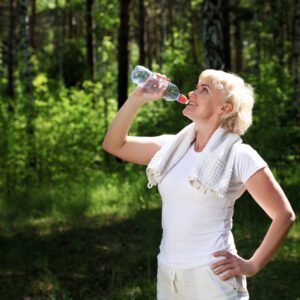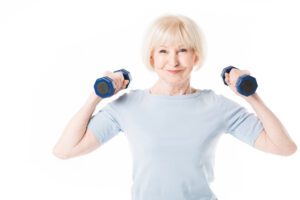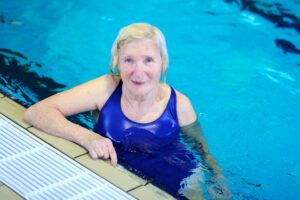 This article looks at the best exercise for seniors.
This article looks at the best exercise for seniors.
Included is an exercise list for seniors containing suggestions of fitness activities and links to reviews of exercise equipment for seniors and exercise DVDs for seniors.
You don’t have to slow down as you grow older. Today, many people live active lives well into their 80s, 90s, and beyond. If you want to join them, start with some minor lifestyle changes.
Getting started is not always easy, particularly if you have been inactive for a long time, are overweight, or have mobility issues.
Regardless of these limitations, your current age and activity level, you can improve your health, fitness, stamina, flexibility, mobility, balance, and sense of well-being.
In fact, studies have shown that middle-aged adults who take up exercise decrease their risk for heart disease.
And recent research indicates that increasing physical activity regularly lowers mortality risk over time, not only for younger adults but also for those who start exercising in their 40s, 50s, 60s, or later.
Keep reading to learn about the best exercise for seniors and how to ease into a fitness program if you are a beginner.
Table of Contents
The Best Exercise for Seniors who are New to Fitness
Functional Fitness –
You don’t have to join a gym or run for an hour a day to make positive changes to your life.
The first thing to work on is your flexibility, mobility, strength, and balance.
Improving these will make it easier to do everyday things such as standing from a seated position, climbing out of your car, kneeling to tie your shoelaces then getting back up, and a myriad of other things that can become harder to do as we age.
Improving your functional strength will have numerous benefits, including enhancing your strength, flexibility, and balance.
With more strength and better balance, your risk of having a fall that could result in broken bones, or worse, will decrease.
Flexibility is a crucial component of mobility, and without it, you will be more prone to injury.
To improve your flexibility, strength, and mobility, do stretching exercises. These should include static, isometric, and dynamic stretches.
Static Stretches –
Static stretches place light tension on muscles, increasing flexibility. Hold the stretch for 20 to 45 seconds, making sure not to bounce.
Isometric Stretches –
Isometric stretches improve flexibility and strengthen muscles.
They involve performing a static stretch, then gently contracting the stretched muscle. Each isometric stretch should be held for 10 to 15 seconds.
Dynamic Stretches –
Dynamic stretches take the muscles and joints through a full range of motion. They should be held for 30 to 60 seconds.
To further improve your range of motion, use a foam roller.
A recent study found that combining static stretching and foam rolling is far more effective than doing one alone.
Balance Exercises –
No exercise for seniors program would be complete without moves that improve balance.
Here are two simple balance exercises you can do at any time.
The first is to walk across the room, placing one foot directly in front of the other, heel to toe.
Another one is to stand on one foot. It’s best to do this beside a wall or solid object so you can steady yourself if you think you will fall.
Closing your eyes while standing on one foot will increase the challenge.
Using a balance board is another excellent option.
Strength training
Strength training is among the most valuable exercise for seniors. 
Starting from around age 30, we lose 3% to 5% of our muscle mass per decade. This process is known as sarcopenia.
With less muscle, we are weaker. Mobility is negatively impacted, and the risk of falls and fractures increases.
A 2015 report from the American Society for Bone and Mineral Research (ASBMR) found that individuals with sarcopenia are 2.3 times more likely to suffer a low-trauma fracture such as a broken leg, arm, wrist, collarbone, or hip if they have a fall.
While we can’t entirely eradicate sarcopenia, strength training can minimize its effects.
Doing a resistance band workout two or three times a week will strengthen your muscles and improve your range of motion without stressing your joints.
Alternatively, you can use light dumbbells to target your upper body muscles.
As well as toning and strengthening your muscles, dumbbell workouts help build bone strength. Strong bones will make you less prone to falls and bone breaks.
Click this link for free access a bone-strengthening workout that incorporates weights.
Or click here to read about the many benefits of strength training for seniors.
How to Start Exercising
It doesn’t matter how old you are or how long since you’ve exercised, you can begin incorporating more physical activities into your life.
Your first step should be to determine your limits. Once you do, push yourself to but not beyond them initially.
By implementing changes gradually, you won’t be overwhelmed, and you will reduce your risk of injury.
Setting goals you have no hope of achieving will discourage you and likely cause you to give up on getting fit.
Walking is an excellent starting point, but any low-impact activity you enjoy will be just as effective.
Finding an activity you love is half the battle won.
By doing something you enjoy, you will look forward to working out. Your endorphins will kick in, and any tiredness or joint pain you’ve been experiencing will fade into the background.
Take every opportunity to be more active.
Walk around the room during the ad breaks when watching the TV. Dance around your living room with your partner or grandchildren. It all helps.
If you find it difficult to stay on track, ask a friend or family member to walk or swim with you.
Start with small changes
Start with small changes, even just one per week or month. This could be something as simple as taking a daily 10-minute walk.
It’s not a race, so there’s no need to overdo it. The right speed is one at which you can carry on a conversation feeling only slightly puffed.
Over time, increase the speed and frequency of your walks, and introduce other healthy habits.
Not overdoing things will motivate you to make more and maybe more significant changes.
The Importance of Diet
Don’t neglect your diet. Even if you aren’t overweight, make more nutritious food choices.
Eating healthier foods will support your immune system, protect against certain diseases and medical issues, and give you more energy.
As with exercise, make one food substitution every week, two weeks, or once a month.
If your diet centers around starchy, sugary, processed foods, make healthier choices at one meal each day.
If you usually have a sugar-packed cereal for breakfast, swap to a healthy one. These days, many nutritious cereals taste great and will satisfy a sweet tooth.
After a few weeks, change another unhealthy food habit. This could be swapping the ice cream with chocolate topping you have for dessert to yogurt with berries.
Reward yourself every week that you stick with your workout or healthy eating plan, but don’t make your reward food.
Instead, catch the latest movie at the cinema you’ve wanted to see. Or buy a book, a magazine, lipstick, or nail polish.
Exercise List For Seniors
Following is an exercise list for seniors. There are other options, but these are among the most gentle for those just starting.
Some of the activities below offer more cardio benefits than others, but all will improve your mental and physical health and functional fitness when done regularly. 
- Walking
- Pilates
- Yoga
- Chair yoga
- Indoor cycling
- Balance board workouts
- Dancing
- Swimming
- Water aerobics
- Fitness band workouts
- Bodyweight training
- Dumbbell workouts
- Tai Chi
Exercise DVDs for seniors
I highly recommend the Zumba Gold workout DVD. It’s gentle enough for seniors and beginners of all ages, and it will enable you to get fit while you’re having fun.
If you’re looking for something more relaxed, check out the Gaiam Yoga Beginners Kit, which contains everything newbies need to start practicing yoga.
The Tai Cheng Workout is another great option. The workouts are gentle, the pace is slow, and Tai Chi benefits are numerous.
Click this link to read more DVD & DVD workout kit reviews.
Exercise Equipment for seniors
The Stamina Wonder Exercise Bike is also worth a closer look. A semi-recumbent bike that places minimal impact on the joints, it comes with detachable resistance bands so you can exercise your upper body as you cycle. It is compact, folds to store, and is quite affordable.
If you have a bigger budget and the room for an elliptical, it’s hard to go past the Teeter Freestep Recumbent Cross Trainer. & Elliptica. Workouts are done seated and target the upper and lower body with zero impact placed on the joints. The machine has a user weight capacity of 300 pounds.
The XTERRA Fitness RSX1500 Seated Stepper offers similar benefits to the Teeter Freestep but is slightly more compact and comes in at a lower price point. It, too, has a weight limit of 300 pounds.
To improve your range of motion and flexibility, the Resistance Chair Exercise System is worth considering. It doesn’t offer significant cardio conditioning, but it’s a starting point if you are carrying a lot of excess weight and don’t yet have much mobility.
A portable mini peddler such as the MagneTrainer-ER or the Vive will enable you to exercise your arms and legs while seated and burn calories as you watch the TV or surf the net on your computer.
To read reviews of more exercise equipment, click on the relevant category at the top of this site’s homepage.
Best Exercise for Seniors Summary
Active living is one of the keys to a long, healthy, and happy life, and it’s never too late to start.
Granted, it can be challenging if life’s events have caused you to fall off the fitness wagon or you’ve always been sedentary. Even more so if you suffer from joint pain, weight issues, a lack of energy, or other issues that seniors can face.
Starting is the hardest part. You can do it if you put your mind to it, though, so don’t give up on yourself. Once you begin to see and feel the benefits regular activity brings, you will become hooked.
Willpower will only get you so far. With so many options, there’s no need to do an exercise you don’t enjoy. Make small, consistent changes and choose fitness activities you love.
Remember, you can benefit from exercise at any age, but the sooner you start, the better, so start today!

